Denham Remembers World War 2
- DCHP
- Nov 22, 2021
- 23 min read
Updated: Nov 25, 2021
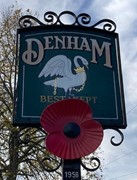
In the first of our posts on Denham and the two World Wars, the focus was on World War 1 often referred to as the Great War. In this second post for the month of Remembrance Sunday we share some memories of life in the village in Word War 2 and its aftermath
The Second World War: how it began.
In November 1918, whilst he was recovering from temporary blindness caused by exposure to mustard gas whilst serving in the German army, a 29 year-old Austrian born painter received news of Germany’s capitulation to the allied forces. He was enraged. He had been praised for bravery through some of the most horrific battles of the First World War. He had been wounded on The Somme in 1916. Like many other Germans he was convinced in his anger and his rage that his adopted country, and its army undefeated on the battlefield, had been betrayed by weak politicians and by enemies within, the so-called “November Verbrecher”, the criminals who had signed the armistice on 11 November 1918. He determined that he would act to redeem Germany’s honour and glory. But this man was an aggressor and a dictator with wild, cruel and vindictive obsessions. Twenty-one years later he would order the German armies to invade territories in Poland the security of which had been guaranteed in 1919 and with which he had himself promised to comply. His action restarted the war that had ended in 1919. His name was Adolf Hitler.
Here a few stories are told of how the terrible and tragic events that occurred between September 1939 and May 1945 (and beyond) impacted on the people of Denham Village. We have been fortunate to have been able to talk with residents of Denham with long memories, some of which have included the war years. They have shared their childhood recollections as well as an insight into the parts their family members played. Where possible we have included their own words. Each story is a treasured recollection of how the village coped as another war raged around the world.
The sadly late Jessie Sims
"In 1939, after living ten years at 3 Nursery Cottages, my family moved into Priory Close, a new council housing estate off Old Mill Road. Sixty-three families moved in on the same day. Priority was granted to those families who had been living in the area, while evacuees were relocated into the old houses. Evacuees, who came mostly from London were part of the government project to re-locate people from the city to smaller, rural communities. Although the program was primarily to keep children safe during German bombing raids, some adults were evacuated also. It was a compulsory move for the residents, otherwise the evacuees would have been put into the new builds and would probably have stayed on.
In 1940, the Flemings (Jessie's family) could see from their windows the search lights over London and the barrage balloons to stop the aircraft from landing. They had an air raid shelter in the garden, and I even had a birthday there. Our shelter was made from corrugated iron shaped into a tunnel, with steps down into it and a door. The air raid sirens did not frighten me; however, I was terrified of thunder and especially lightning. Our father Alexander was a fire watcher (in the Home Guard) and he did have a gun.
Everyone knew everyone else in Priory Close. It was a community of 63 families who had moved into the new houses with enough bedrooms to accommodate large or small families. It was a mixed group of ages too. Early on, there was not a car in sight.
My house in Denham Green is called Gairloch. It is named after an area on the west coast Scotland, where my husband Wally Sims was based during the latter part of WWII. The military were minesweeping up to Iceland from Loch Ewe, a very large, deep sea loch with a narrow neck where it had installed a boom to stop the enemy submarines from getting in."
The Home Guard

On May 14th 1940, a radio appeal was broadcast appealing for local people who were ineligible for military service to become Local Defence Volunteers to be part of a secondary defence force in case of an invasion by Nazi Germany's forces, which then seemed imminent. 1.5 million responded and by Friday May 1940, Colonel P A Hall had become commander of the volunteers for Buckinghamshire.
By June 1940 the national force had been renamed ‘The Home Guard’ and with it there was a move towards the requirements of a regular army with both commissioned and non-commissioned officers, uniforms and a mild framework of discipline. Its role was more precisely defined:
“to try to slow down the advance of the enemy even by a few hours to give the regular troops time to regroup. They were also to defend key communication points and factories in rear areas against possible capture by paratroops or fifth columnists. A key purpose was to maintain control of the civilian population in the event of an invasion, to forestall panic and to prevent communication routes from being blocked by refugees to free the regular forces to fight the Germans."
For its Home Guard, Buckinghamshire County was divided into seven areas coincident with the local police divisions. At first there were no formal ranks, no Captain Mainwaring of "Dad's Army" fame, simply a group of local people protecting the areas in which they lived. Men aged 17 to 65 years could join, although the upper age limit was not strictly enforced. Service was unpaid but gave a chance for older or inexperienced soldiers to support the war effort. At first in Buckinghamshire there were no uniforms, no weapons nor any financial support - in spite of the large amount of work required.
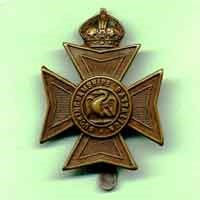
The traditional Buckinghamshire swan was adopted as the design for the cap badge of the Buckinghamshire Home Guard. Denham was part of the 5th Battalion together with Beaconsfield and Gerrards Cross under the leadership of Lieutenant Colonel P.M. Beachcroft OBE and Lieutenant-Colonel W. Gibson, DSO OBE, MC. There were thirteen battalions in Buckinghamshire plus the 101st Rocket Anti-Aircraft Battery, the 71st Heavy Anti-Aircraft Battery and the 2003rd Mechanical Transport Company.
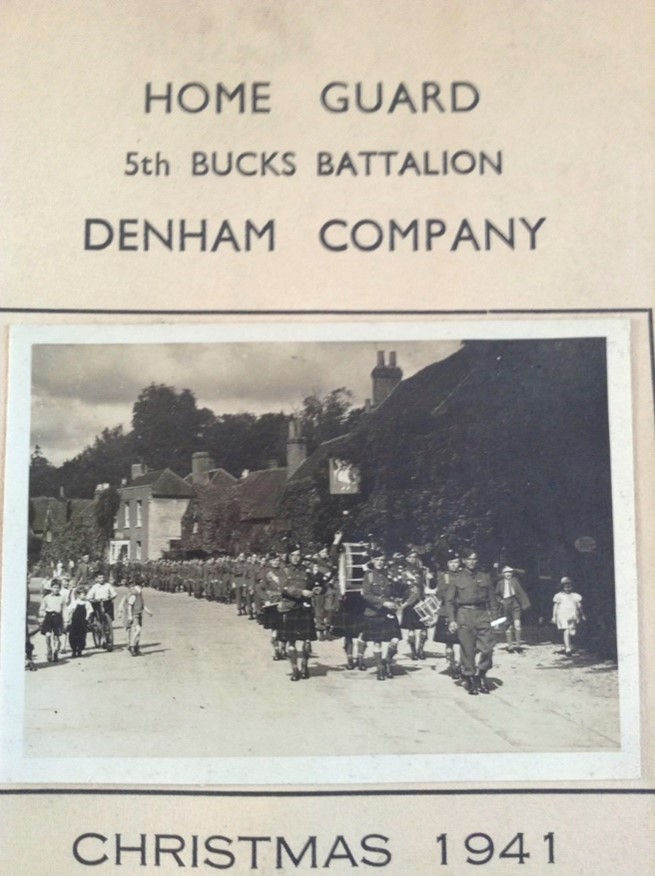
The Home Guard continued to man roadblocks and guard the coastal areas of the United Kingdom and other important places such as airfields, factories and explosives stores until late 1944, when they were stood down. They were finally disbanded on 31 December 1945, eight months after Germany's surrender.
Ann Collins
“When World War II started, I was two years old. I can remember collecting my Mickey Mouse gas mask from the garage opposite Fayrstede, then taking it to school.
We didn’t have any of the usual annual celebrations as such while the War was in full swing. I remember the air raid sirens and the ‘all clear’ siren.
During the War, my parents took in relatives from Blackheath to live with us; after 1945 we always had a lodger – mainly from Denham Film Studios. I can remember my class being taken up to the main A40 to see Winston Churchill going by in an open top car. He smiled and signalled with his usual V sign.
Yes, I remember rationing, ration books and clothing coupons. After World War II was over, I remember being shown a banana for the first time. Before the Second World War started, Britain imported about 55 million tons of food a year from other countries. After war was declared in September 1939, the British Government had to cut down on the amount of food brought in from abroad because German submarines started attacking British supply ships. There was a worry that this would lead to shortage of food supplies in the shops, so the British Government decided to introduce a system of rationing. This made sure that people got an equal amount of food every week. The Government was worried that as food became scarce, prices would rise and poorer people might not be able to afford food, leaving none for others. Bacon, butter and sugar were first rationed in January 1940; other items were added throughout the years. Rationing of food lasted for 14 years until July 4th 1954.”
Rations
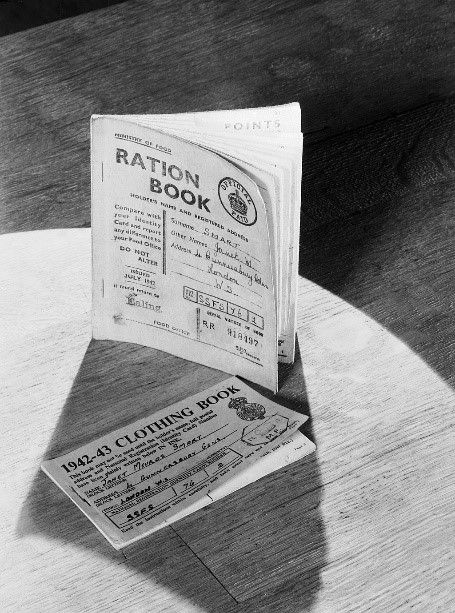
As Ann recalls, the rationing of food began in January 1940. Every adult and child was given a ration book of coupons. Each household had to register with a specific retailer. Some items such as tinned foods, dried fruit, cereals and biscuits were allocated points which changed according to availability. Fruit and vegetables were not rationed although those items that came from overseas were often unavailable.
People were encouraged to grow as many vegetables as they could and posters with the slogan, “Dig for Victory” were a common reminder. Food items for one week per adult would include: - butter (50g), sugar (225g), cheese (50g), bacon and ham (100g), one fresh egg, margarine (100g), milk (3 pints) and tea (50g). Children received extra milk plus orange juice and cod liver oil deemed essential for their growth.
As well as food, petrol was rationed in 1939, clothes in 1941 and soap in 1942. Even after the war it was another five years before most of the items were no longer rationed with the final products such as meat completely freely available in 1954. Many post-war babies grew up believing the weekly shopping list was called ‘the rations”.
All systems can be open to abuse and this was no exception. Some rationed items were sold without coupons for hugely inflated prices and petty criminals, obtaining goods by other means traded illegally. By March 1941, 2,300 people had been prosecuted and penalised for fraud and dishonesty.
Jane Mills
"When there was still rationing, I was living in Bristol where my sister and I grew up. In fact, I still have my mother’s old, leftover ration cards. One special memory was going to the sweet shop on Saturday afternoons with my father when I could choose whatever I wanted within the limits of the ration card. I knew nothing about bananas, but in 1950-51, I went with my father to an area above the Avon Gorge to watch the first Ffyffes boat carrying bananas to the UK. Soon after, I was able to buy them in the store - but they were rationed."
Christine Webb
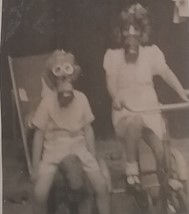
“The Second World War was still on when I started school in a large hut at the top of Old Mill Road. If the air raid siren sounded, we had to go into the air raid shelter opposite. I had no fear of what war meant at that age. My only concern was that I had left my lovely new navy-blue coat in the school and it might have got blown up."
The photo here shows Christine and her sister Janet in their gas masks.
“My earliest memory was during the war when my father decided that to be safe, we should sleep in the reinforced concrete brick air raid shelter built in our back garden. We did for one night after which my mother said 'war or no war we are never sleeping in there again' . I believe the odd spider or beetle terrified her. After that we all slept in the double bed for a while. "
Below, the air raid shelter at 5 Baconsmead.
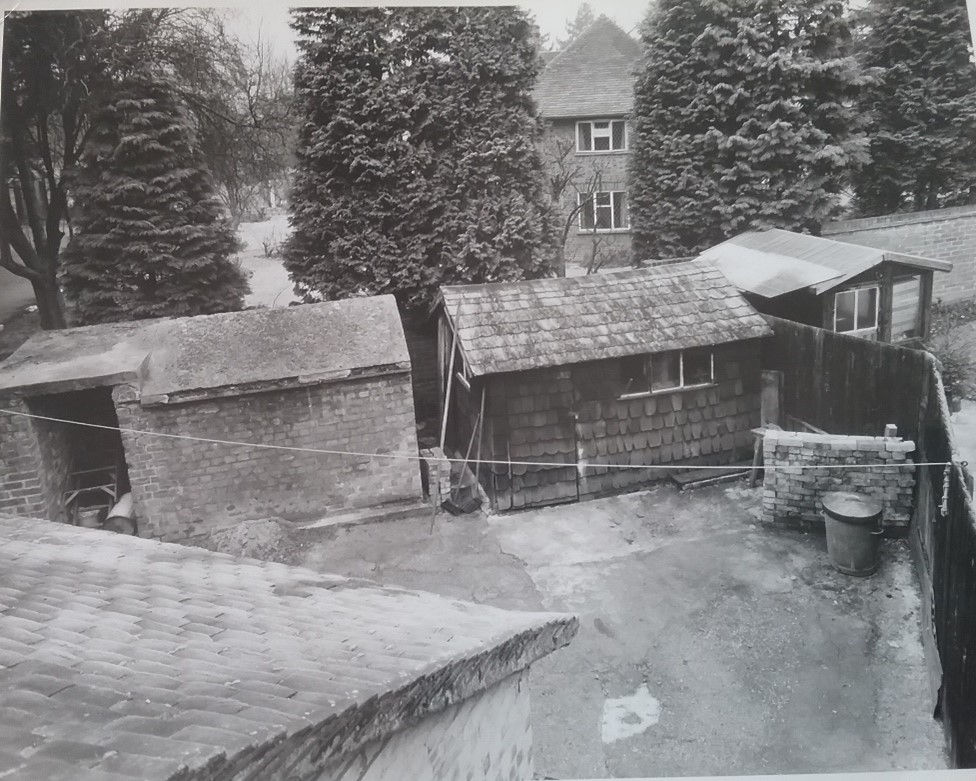
"When I mentioned at work years later that no one could possibly dismantle that air raid shelter, it created a challenge to the engineers I was secretary to and, during their lunch break, for a week, four of them, each with four-pound hammers actually demolished the whole thing. I think the fillet steak lunch I gave them every day may have helped.
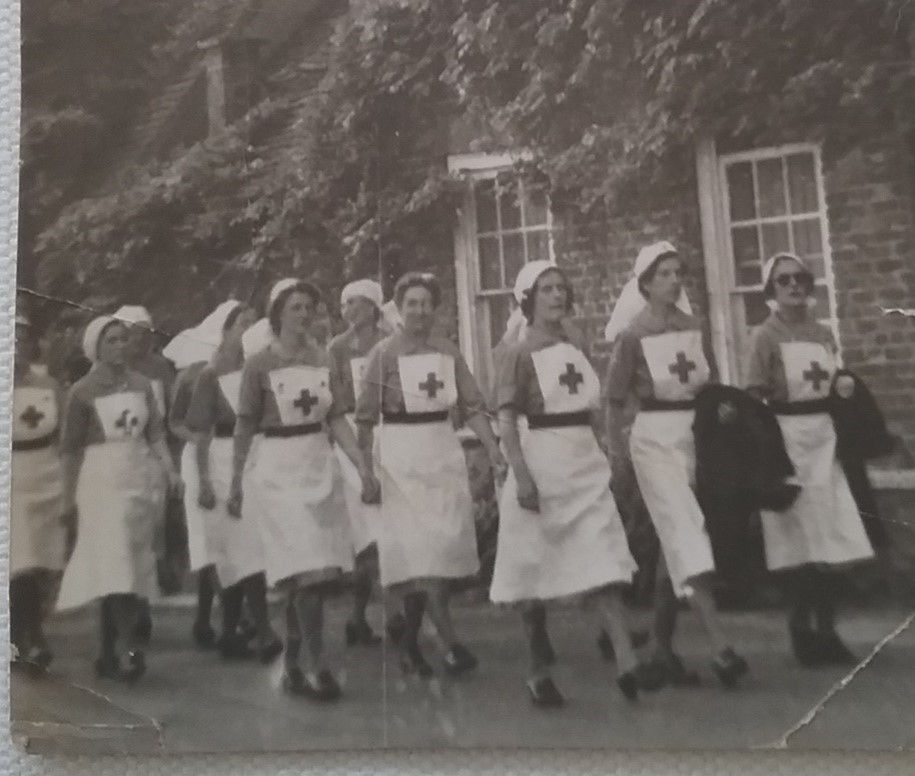
My mother was in the Red Cross during the war and afterwards. I believe Madelene Paton (the doctor's wife) was also involved. My mother had several proficiency medals and certificates which I now have. She often had meetings in our sitting room in Baconsmead, training members of the Red Cross and I regularly had to be the 'patient' (my sister always managing to be somewhere else). I actually enjoyed it and still remember how to do a herringbone bandage and correctly fit a cotton sling. This is a picture of Red Cross nurses marching past the house in the village once owned by Sir John Mills. My mother is fourth from the right.
As children we were not allowed to leave the table until we had eaten everything on our plates. Probably why I dislike pasta today as we were made to eat macaroni which I hated. Of course, food was scarce after the War, so I understand their reasoning. I remember the meat shop in Denham village later becoming a paper shop run by a Mrs Evans and also the grocery shop. When rationing was introduced, my mother would send me to the village grocery shop to get our rations. I remember the blue sugar bags plus a lady working the butter into pats for customers.”
Iris Harvey
“I remember a couple of things about the war. My mother fell off her bike and broke her leg in two places which meant a long stay in hospital. My father would visit her on his bike and the first time had completely the wrong address which meant a long ride to find the right hospital. The other memory of the war I have is when a bomb was dropped at the end of our road. It broke the water main and the whole of the bottom part of our house was flooded. I remember us all having to live upstairs for a while together with our neighbours who rented Rosebank from my parents which was also flooded. My husband had a very unhappy time in the war as an evacuee. I’m not sure he ever really recovered from the trauma.”
Gwen Horney (Iris' sister)
“During the war years we had a concrete square air raid shelter in the garden where we used to play as well as go to keep safe. My mother was in hospital during the war as she had fallen off her bike and broken a leg. My sister was born on VE Day. My father was in France in the war and spoke very good French by the end.”
Val Dewhurst
"I was nine years of age at the beginning of WWII. I remember well when an airplane crashed into our house while we were in it! I was in Devonshire, living with my grandparents, mother and brother. While in the garden, my mother saw an airplane come around, then stutter as a German plane was shooting at it! The airplane crashed into our large house. At the time my brother was in the bath. Soon, bullets were flying everywhere because the magazine in the downed airplane had exploded. My mother ran back into the house to get us children with loud instructions to hold onto her hand and not let go. With my brother wrapped in a towel under her arm, she stepped over the dead men and got out of the house. Our house burned for three days. Suddenly, we were homeless and without any possessions, so we went back to London. The government gave our family £400 pounds to start over.”
Val and her husband Alan, who had been in the merchant navy during the whole of the war, married in 1954. She remembers being rationed for bread and potatoes between 1946 and 1948 after the war had ended. "No sweets", is one of Val's starkest recollections. In fact because of the economic consequences of the war, rationing of several items was stricter after 1945 than during the war itself. Rationing did not end completely until the year Val and Alan were married.
Margaret Ashbrook
Margaret Ashbrook, nee Balfour, lived in Wrango in the Village from 1952 until her death in 2018 aged 101. As she turned 100, one of her daughters, Kate, wrote a short biography which included a passage about Margaret's work as a "land-girl"
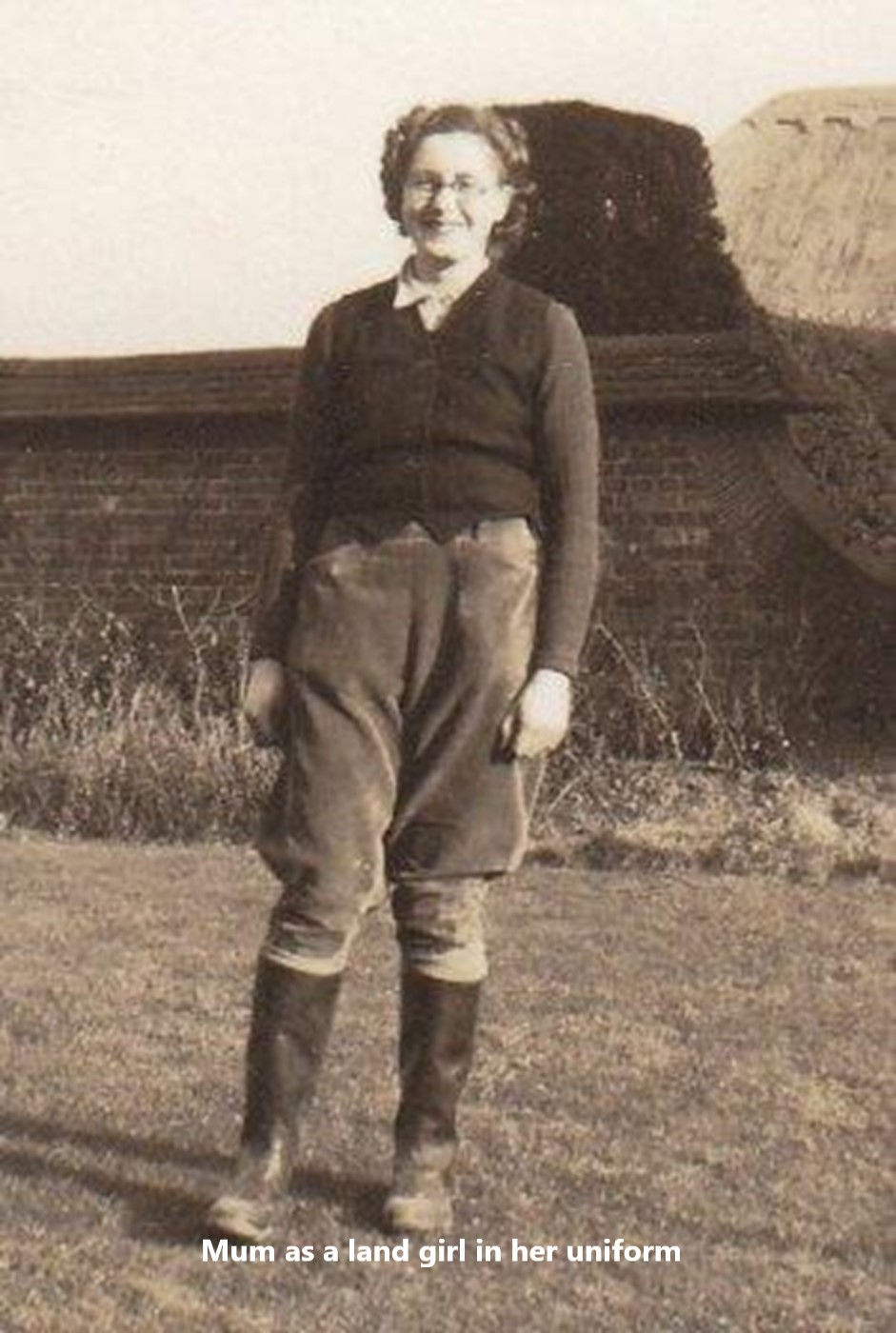
“During the Second World War Mum became a land-girl (1942-6) at Great Dixter in East Sussex. She milked cows, tended pigs and chickens, brought in the hay and drove the pony cart to collect the oats from the fields for threshing. She looked after a pony called Patience, who did not live up to her name.
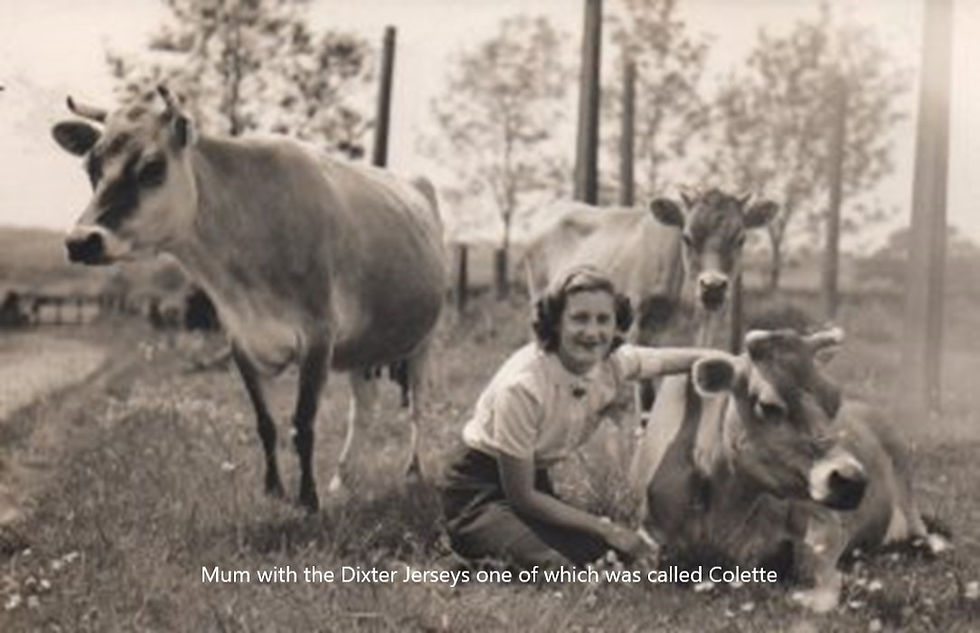
Great Dixter was owned by the Lloyd family (the late Christopher Lloyd was a well-known gardening-writer). For the earlier part of the war Mum also manned the early-warning post at Dixter. She wore the traditional land-girl’s sweater and breeches with overalls over her breeches, which she considered ‘unbecoming’. She worked very long hours.
In 2008 she received the government medal for her services to the Women’s Land Army.”
Women’s Land Army
So who were the "land-girls" ? More appropriate to the modern reader is the official title The Women's Land Army.
“The land army fights in the fields. It is in the fields of Britain that the most critical battle of the present war may well be fought and won.” Lady Gertrude Denman
Lady Denman was the Director of the Women’s Land Army. Over 200.000 women were members of her organisation between June 1939 and November 1950. They were essential workers for the country when food was in short supply and so many male farm workers were at war. They were recruited from urban areas as well as rural, living at the farms where they worked. A quarter of the "land girls" worked in dairy farms with others working as rat catchers in anti-vermin squads.
Other types of work included working with prisoners of war on the farms, forestry work such as felling, sawing and lifting timber as well as excavating land for reclamation, driving tractors and other large farm machinery. Some worked in the gardens of large private country houses and some even at Kew Gardens. They commonly worked 48 hours a week in winter and 50 in summer, with no holidays until 1943 when one week a year was allowed. Their pay was less than the men for the same jobs. Men received 38 shillings per week, women, 28s.
Peter Morgan
The written autobiographical recollections of lifelong Denham resident Peter Morgan have been made available to us by his daughter Chris Jonas. Peter Morgan's own father Oscar was a casualty of the First World War. Oscar died in 1925 aged 35 when his son Peter was just 5 years old. Oscar's health had not recovered from his wartime experiences.
Peter spent his early childhood with his mother and grandparents in one of the Island Cottages which stood on what is now the Village Green. He and his mother and grandmother later moved across Village Road to a tiny cottage next to The Falcon. and then in 1939 Peter moved into 4, Priory Close. By this time Peter, aged 19, had volunteered to join the Territorial Army Royal Engineers and he was "called to arms" on August 24th 1939.
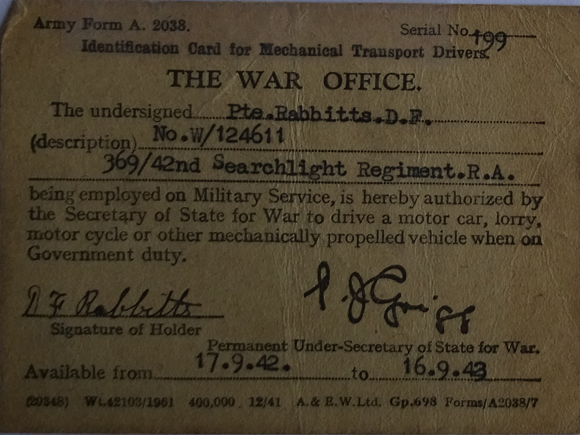
He met his future wife Dorothy Rabbitts while she too was playing her part in the war effort. Peter's story provides another example of the importance of the wartime role of women. Dorothy's preference had been to join the navy and, in the process, learn to drive. She joined the Auxiliary Training Services and was sent to Aldermaston for her basic training. From there she was transferred to Wexham, Wales for driver training. Her first post was with a searchlight regiment, nicknamed ‘The Robin Hoods’ in Market Rasen, Lincolnshire. Her next post was a transfer to 426 Searchlight Division, Leal, Gainsborough. It was here that she met Peter. After the war the couple were married and made their home in Priory Close. Their daughter, Chris recalls post-war village life as a happy time despite the restrictions on food supplies.
Doctor Ian Alexander Morris Paton
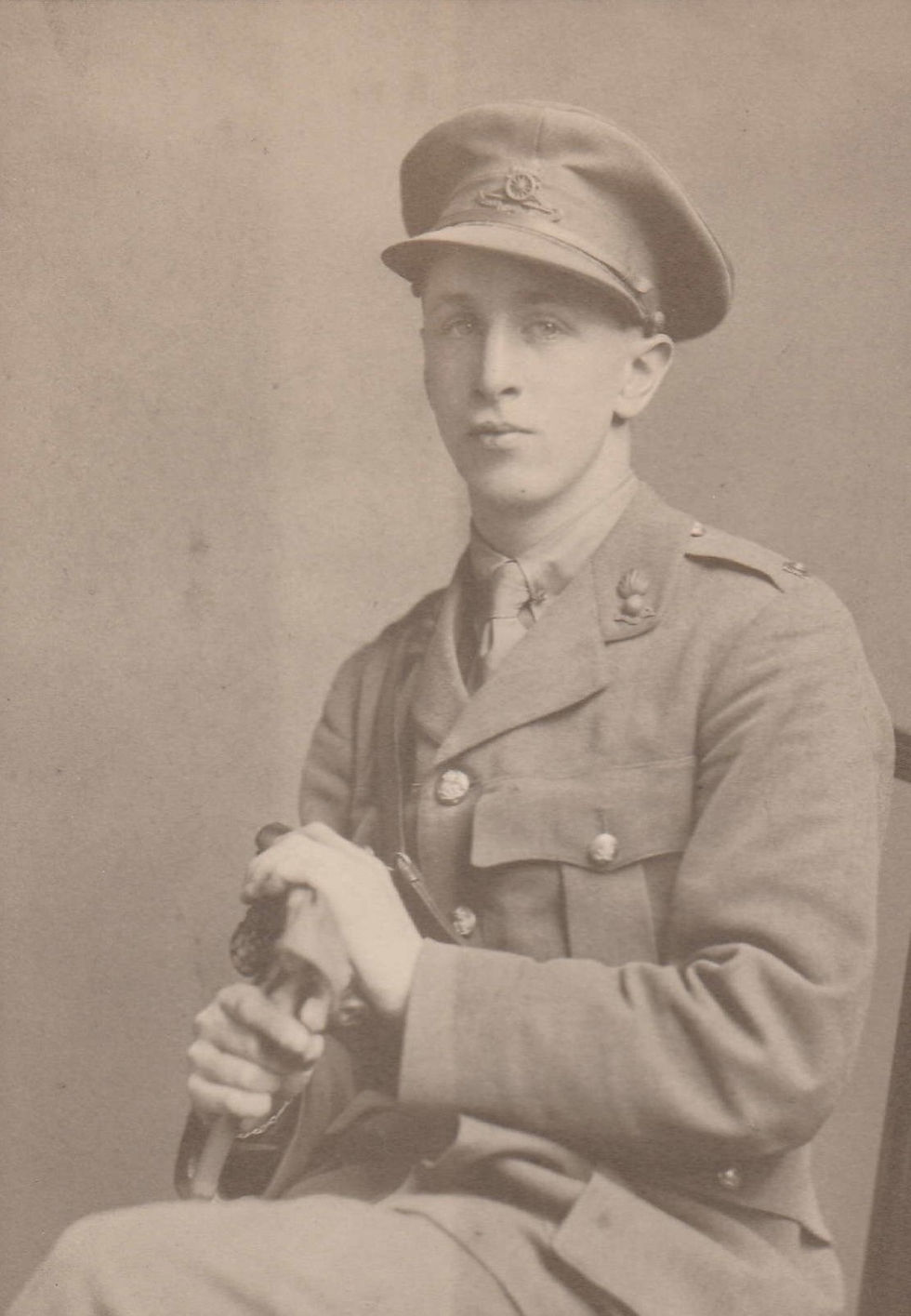
Doctor Ian Paton was a much-loved Denham GP as evidenced by so many villagers’ comments about him. He was married to Madelene, daughter of Francis Bacon the architect responsible for the design of many of the village's 20th century buildings and the war memorial. Their son, Mac Paton, kindly shared a childhood tale at the end of previous post, Denham Remembers World War 1 .
Dr. Ian Paton saw active service during WW2 making good use of his medical skills and knowledge as a leading member of the Royal Army Medical Corps. He was at Dunkirk in 1940 as the British Expedition Force in mainland Europe was forced to evacuate and in 1944 he was on the D Day beaches as the allies returned in Operation Overlord to begin driving the German Nazi forces out of France and to ultimate defeat.
Throughout his service Ian Paton tried to keep in touch with his patients back in Denham and Uxbridge, urging Madelene to pass on messages to them whenever he had information about their loved ones. Madelene, an energetic and dynamic person in her own right, helping others and Denham causes with gusto, did turn her husband down after one request from him. The family had a small boat and she absolutely refused to acquiesce to his request to take it to Dunkirk.
In 1945, Dr. Paton was recommended for an OBE with the following comments:
“This officer has worked without ceasing and without sparing himself, in the planning stage of OVERLORD and since landing in France on D+2. During planning his advice was always sound and no detail of his work was too small to escape his notice. Since landing, his main pre-occupation has been the arrangements for the reception of the CEP and the dispatch by various means to the UK of the Army’s casualties. So far, some 70,000 have been so evacuated and the success of this great and important work is mainly due to Lt Col PATON’S energy, foresight and tireless hard work.”
Peter Wildsmith, evacuee to Denham
In 2003, Peter Wildsmith contributed to a collection of archive material of memories of World War ll, gathered together by the BBC. This is a fascinating archive. Peter Wildsmith's contribution tells of his time in Denham:
“We that’s Mum and Dad and my older brother by five years were all to be evacuated, not the usual evacuation however to distant rural parts, but to a camp in Denham, Bucks. Not many miles from London!
The evacuation to Denham was so that the company my dad worked for, George Wimpey & Co. could concentrate on the war effort.
Denham was a place in those days more famous for the British film industry. J Arthur Ranks film studios were nearby and from the bus on the way to school in Uxbridge I could see the open-air film sets in the distance. My years as a toddler were all in this camp and incredibly considering how young I was I can still remember bits of the war years; my brother though can’t remember much despite him being five years older.
I recall seeing from the bus on the way to school some prisoners of war digging trenches by the roadside. I can also recall the lead up to the invasion with the lorries, tanks and the invasion aircraft, some pulling those terrifying gliders full of our soldiers!
I was lying in bed one night when I saw this flame go over, it was a Doodlebug, the V1. It landed somewhere near the neighbouring airfield.
There were dog fights and a parachutist descending but I must say I couldn’t see this as I was so small and there were all these grown ups in the way but everybody was pointing excitedly to the sky.
I had my own gasmask; we even had air raid shelters covered in grass like burial mounds. I remember these mounds in particular because of the terrifying experience of being chased past these shelters by this enormous white cockerel. I must have been only about four years of age then and this bird did seem big, glad to say it’s never put me off eating chicken.
We lived in single storey wooden huts and then later brick ones but they lacked cooking facilities and toilets, a heavy enamel bucket was our convenience for the night.
I remember our toilet bucket vividly for one morning and being a small boy and doing what small boys do, I thought it would make a good helmet. I lifted it up to put on my head, the bucket lid fell out and of course the previous night’s contents covered me completely.
The surroundings now seem idyllic with the camp situated next to woods and fields and not far away a small airfield which is now Denham flying club. There was even a very small outdoor swimming pool, not very clean though.
Being in the countryside meant climbing trees, making dens and pretending we were in the jungle making Tarzan swings, playing Cowboys and Indians and that sort of stuff and starting fires. Oh dear!”
The Village School Logbook entries:
1939 September 1st – Owing to a national emergency being declared, school is closed until further notice. The school building is being used as a dispersal point for evacuated children.” School reopened on September 18th but from the records it would appear some teachers left to report for duty in the war and several volunteers were brought in.
1940 The Infants are at the Girl Guide Hut (top of Old Mill Road) and the boys from the evacuated schools are at the Parish Hall. The girls and infants from the evacuated schools are included in the Denham School.
1940 September 9th – it has been decided that children will not go into air raid shelters unless local air activity is threatened. October 21st – Owing to the frequency of air raid warnings near 4pm, it has been decided to dismiss between 3.30pm and 4pm according to local conditions.
1945 May 8th – school closed for two days to celebrate VE Day
Was Denham bombed?
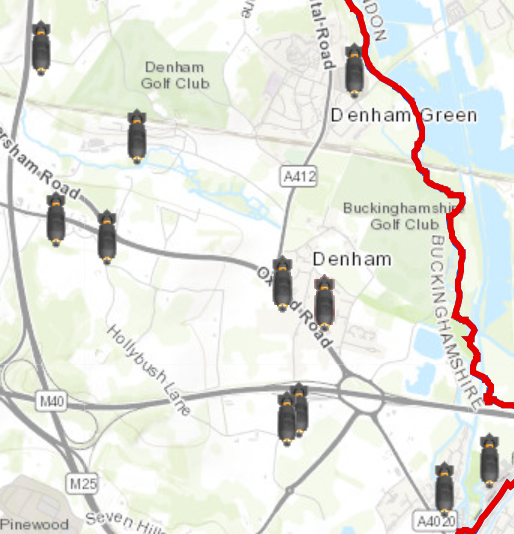
Yes, the map here taken from the records held in the Buckinghamshire Ardchives of Bucks County Council shows where Denham was hit. It is not claimed that the maps is 100% accurate since the records themselves may be imprecise but the map does indicate that the village's proximity to London, its aerodrome, the factories in Langley and the headquarters of Martin-Baker all contributed to Denham and its surroundings being a target,
Sir James Martin and the Martin-Baker Company
The headquarters of Martin-Baker have been sited in Higher Denham since 1929 in the area previously used as a camp for the 16th Battalion, described in our article on World War 1 earlier this month.
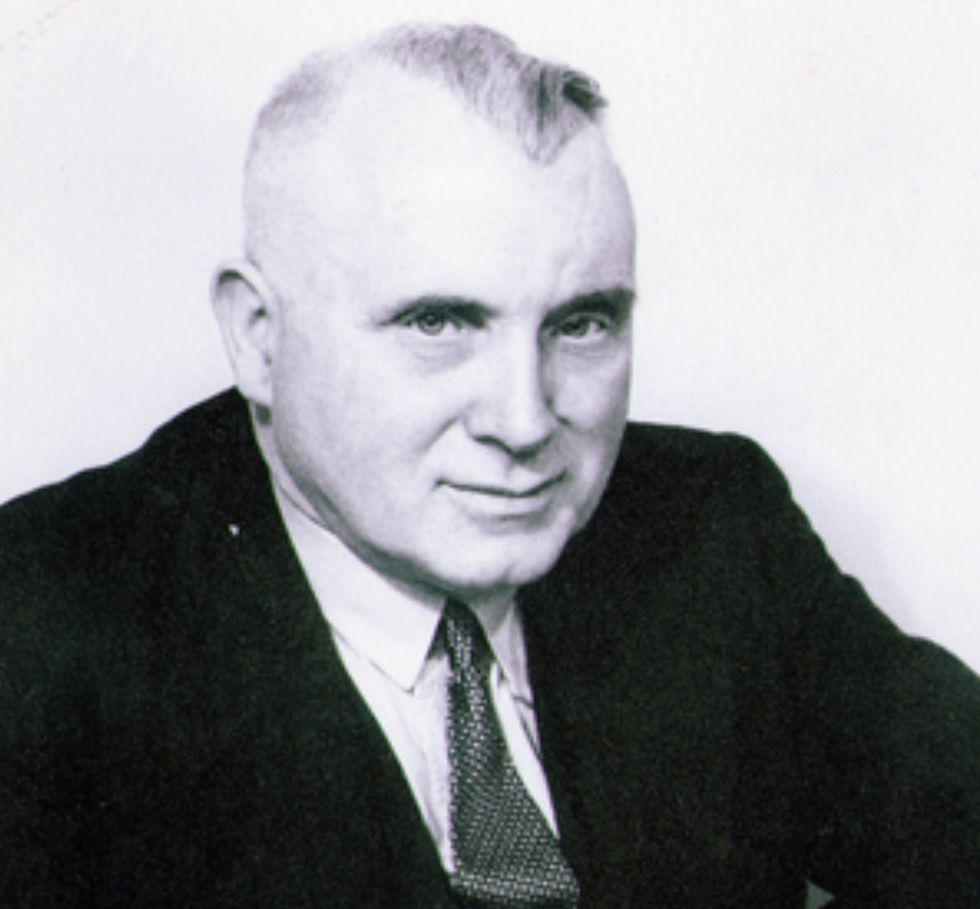

The Martin-Baker Aircraft Company was founded by Sir James Martin and Captain Valentine Baker in 1934. Sadly, Captain Baker was killed during a test flight in 1942. Two years later, Sir James Martin was invited by the Ministry of Aircraft Production to research the provision of a fighter aircraft with a means of escape. The idea of the ejector seat was pursued with the first live test in 1945, just too late for deployment during the war. The first pilot was saved in 1949 and since then a further 7,500 lives have been saved using this device.
Although too late for the war years, the company had created another device. This was the balloon cable cutting device for aircraft. It was Sir James Baker himself who designed the standard cable cutter for fitment to aircraft wings.
“The principle of the cable cutting experiments was to ensure that the flying cable was such that it made an angle of 45 degrees with the horizon. From the balloon a single cable was dangled vertically down with drogue parachutes attached and warning flags. The aircraft would deliberately fly into the cable and attempt to cut the cable using various methods such as hardened leading edges to the wing. It was eventually found that a small cable cutting chisel fired by an explosive bolt was the answer. As the wing hit the cable the aircraft slewed around and the cable would slide along the leading edge of the wing and enter a small notch in the wing. This would detonate a cartridge that would fire a hardened chisel and sever the cable in two. The pilot then was able to recover his aircraft from any stall. They were fitted to bomber wings to cut barrage balloon cables that were fitted to many aircraft. It is estimated that around 2,500 lives were saved and 500 aircraft.”
For pictures of the cable cutter, head to the Martin Baker link in "Sources" below.
The film industry: Alexander Korda
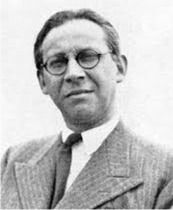
Alexander Korda emigrated from Hungary, arriving in London in the early 1930s. He built the large film studio complex in Denham, lifting the state of the British film industry which was struggling at the time. He and his wife, the actress Merle Oberon were living in Hills House at the start of the war in September 1939, though she departed for America three weeks later to escape the situation.
Films were a vital tool in persuading America to help Europe. Some of Korda’s work was crucial. Korda was initially viewed with suspicion in the US as is evidenced by the US Senate's investigation of his role in making propaganda films, very much frowned on in the United States at the time. This was however shortly before the attack by te Japanese on the US naval base at Pearl Harbour in Hawaii, after which American public opinion really did change regarding intervention in the European war.
Korda attracted the attention of Sir Winston Churchill and more particularly that of his near neighbour at Denham Place Sir Robert Vansittart. A Senior Diplomat at the Foreign Office Sir Robert had by 1938 made himself unpopular in political circles by his repeated warnings about Adolf Hitler's intentions contrary to the then Government policy of appeasement. But his view that every effort must be made to stop Hitler were shared by Churchill who relied a great deal on Sir Robert's advice
Both Vansittart and Churchill liked films and realised their potential contribution to the war effort.
Within a few weeks after the outbreak of war Korda had produced ‘The Lion has Wings’. This film was not approved by Neville Chamberlain's government in 1939 and, though a commercial success it was not all that well received by the British public who viewed its blatant propaganda as rather simplistic. As it was clearly a propaganda film it was not at first sanctioned for showing in the US and when it was eventually shown in America it was given a preface that it was a British propaganda film to show what things were like in the countries that were at war. It is however known that Sir Robert Vansittart spoke well of the film and may well have encouraged its making so keen was he to tackle the removal of Hitler.
The Government with Churchill in the War Cabinet as First Lord of the Admiralty was soon persuaded of the importance of the film industry to a country at war. In May 1940, Korda was called to an urgent with the Minister of Information. It was decided that he should make a propaganda film in Hollywood where it would be less suspicious and indeed safer since Denham Studios took a direct hit during the Blitz bombing. The resulting film, ‘That Hamilton Woman’, was released in March 1941. Laurence Olivier was cast as Admiral Nelson and Vivien Leigh as his lover Emma Hamilton. Olivier’s memorable line was “you cannot make peace with dictators, you have to destroy them, wipe them out.” The International Churchill Society tells us that commentators described this as a sentence regularly used in speeches in 1941. Legend has it that Churchill wrote the line for Korda's film.
In June 1942, Korda was given a knighthood for his efforts. the award was rightly interpreted as great recognition of the motion picture business and its professionals.
The Film Industry - Hugh Stewart
Like so many other 20th century Denham residents, Hugh St Clair Stewart made his career in the film industry. The list of films for which he is credited first as a technician, and, from 1949 onwards, as Producer include many of the best-known drama and light entertainment movies of British cinema in his times.
Rather less well known is Hugh’s work with the Army Film and Photographic Unit (AFPU) to which he was first commissioned in 1940. Much of the footage we see on TV histories of World War 2, including film of the allied landings in France on D-Day, 6th June 1944 and the subsequent battles, was the responsibility of AFPU unit No. 5 led by Major Stewart.
On 15th April 1945, British and Canadian troops entered Bergen Belsen concentration camp in north-west Germany. The camp had already been largely deserted by the Nazi guards leaving some 60,000 sick and starving inmates. The BBC’s Richard Dimbleby was to describe what he witnessed there as “the most horrible of my life”.
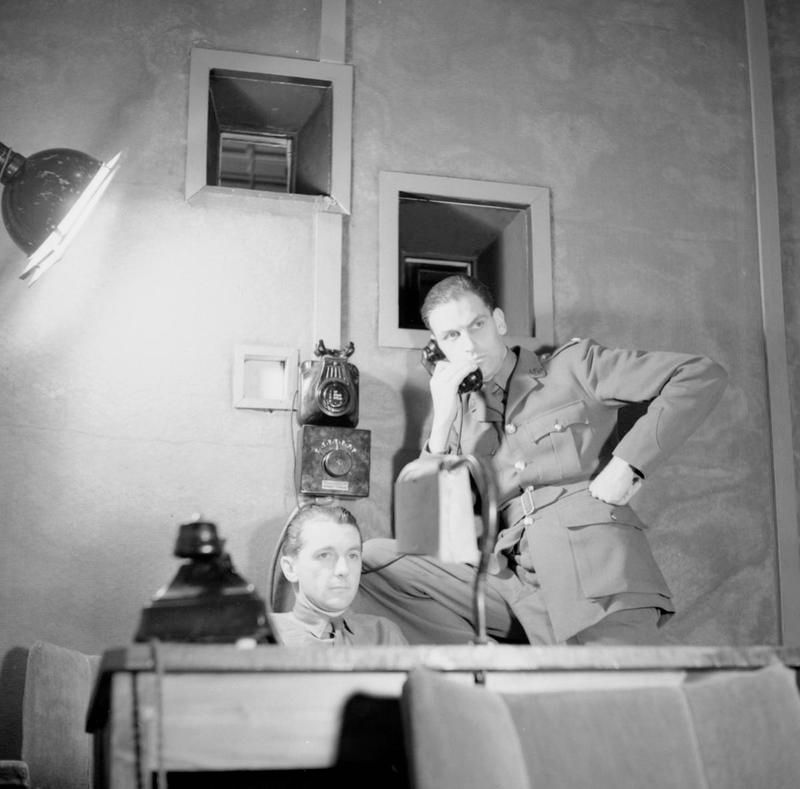
Following close behind the first liberators of Bergen-Belsen was Major Hugh Stewart (standing in the photo) leading AFPU No. 5. He and his team were under strict orders to stay with the British Army as its eastward advance continued. But Hugh resisted and made a direct appeal to Allied Forces Supreme Commander General Dwight D. (later US President) Eisenhower to be allowed to stay behind to record the horrors of the camp. Eisenhower agreed. Hugh Stewart’s never to be forgotten filmed record is both a warning and an inspiration that we must be vigilant against the possibility of any recurrence. The debt owed by the world to Hugh Stewart’s persistence in his appeal to Eisenhower is immeasurable. Hugh was awarded a military MBE for his service and left the army with the rank of Lieutenant Colonel. He died in Denham on 31st May 2011 five months past his 100th birthday.
Royal British Legion
By 1918, Britain’s economy had suffered immensely from the four years of WW1 and recovery was very slow. In 1921, two million people were unemployed, 1.75 million returned from the fighting with some kind of disability and half were permanently disabled. Others who had not gone to war were often financially dependent on those relatives who were lost or injured.
In 1921, to support those who had suffered as a result of service and their families, the Royal British Legion was formed. It was the brainchild of Field Marshal Earl Haig and Tom Lister of the Federation of Discharged and Demobilized Sailors and Soldiers. They brought together this Federation with the National Association of Discharged Sailors and Soldiers, The Comrades of the Great War and the Officers’ Association. The Legion was formed on May 15th, 1921 and the first ever Poppy Appeal was held. The poppies sold out very quickly and raised over £106.000 for employment and housing support for veterans.
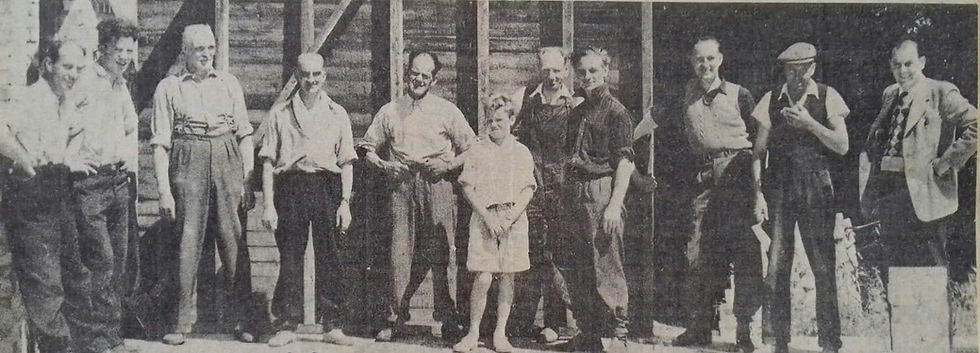
Denham’s own British Legion Lodge No. 5950 was established in 1952 by the men shown in this photo. They include Jack and Geoff Ansell, Jim Ramage and Norman Pratley, Joe Ongley and Wilf Childs, Reg Beason, Bill Sharman and Bruce Cherry. The Lodge's premises were sited on Ashmead Lane. For many years they provided a social meeting place in the village and a source of revenue of the Legion charity. The building has since been demolished and replaced by two houses.
Street Parties
We began with memories from Jessie Simms in which she recollected the camaraderie of living in Priory Close. Might she be in the picture below as families celebrated the end of the war together with a street party?
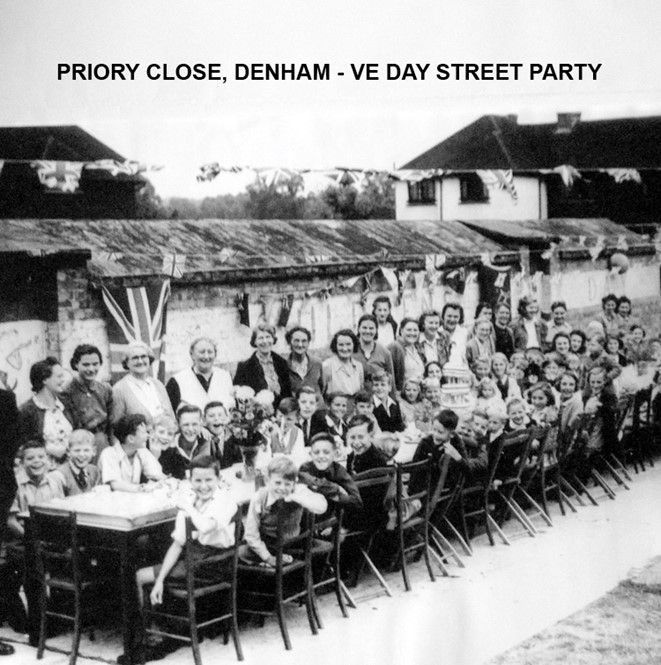
The first street parties were organised across the country in 1919 by local people for mainly poor and orphaned children as part of the Peace Treaty celebrations. These were formal sit-down affairs and set a trend for any important national occasion. The next national one was in 1935 for the Silver Jubilee of King George V, followed by one for the coronation of King George Vl.
VE Day or Victory in Europe Day marked the ending of hostilities between the Allies and Germany in 1945, the end of World War II in Europe and the perfect occasion for more national street parties.
In the UK, May 8th was the day chosen for commemorating the event although it is not a public holiday. Other countries share this date, while some have chosen May 9th or 10th.
Next month: Not exactly a pub crawl, but we will be recalling the history of Denham's inns, hostelries and restaurants.
Sources:
Royal British Legion. britishlegion.org.uk
Denham Village School logbook – transcribed by Margaret Skelton
Third Sector (thirdsector.co.uk)
Buckinghamshire Home Guard by Stanley C Jenkins from staffshomeguard.co.uk
Martin Baker Aircraft Company Limited
www.bbrclub.org/Balloon%20Cable%20Cutting%20Device%20for%20Aircraft.htm
ww2.bfi.org.uk
‘Korda’ by Charles Drazin
WW2 People's War is an online archive of wartime memories contributed by members of the public and gathered by the BBC. The archive can be found at bbc.co.uk/ww2peopleswar' The item reproduced here is credited to Peter Wildsmith, WW2 People's War.
Discovery National Archives
Thanks to those villagers who shared their personally remembered stories or those of their relatives.



Comments